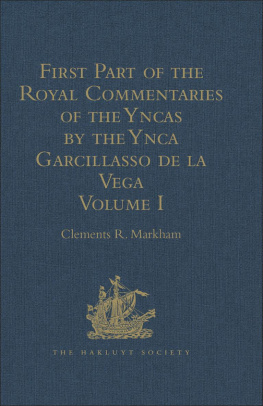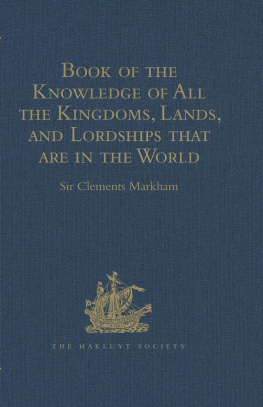
First published by Ashgate Publishing
2016 Clements R. Markham
Published 2016 by Routledge
2 Park Square, Milton Park, Abingdon, Oxon OX14 4RN
711 Third Avenue, New York, NY 10017, USA
Routledge is an imprint of the Taylor & Francis Group, an informa business
All rights reserved. No part of this book may be reprinted or reproduced or utilised in any form or by any electronic, mechanical, or other means, now known or hereafter invented, including photocopying and recording, or in any information storage or retrieval system, without permission in writing from the publishers.
Notice:
Product or corporate names may be trademarks or registered trademarks, and are used only for identification and explanation without intent to infringe.
Founded in 1846, the Hakluyt Society seeks to advance knowledge and education by the publication of scholarly editions of primary records of voyages, travels and other geographical material. In partnership with Ashgate, and using print-on-demand and e-book technology, the Society has made re-available all 290 volumes comprised in Series I and Series II of its publications in both print and digital editions. For information about the Hakluyt Society visit www.hakluyt.com.
ISBN 13: 978-1-4094-1327-1 (hbk)
CONTENTS OF THE FIRST VOLUME
NOTICE.
The two Volumes are paged throughout, and the Index will be at the end of the Second Volume.
WORKS ISSUED BY
THE HAKLUYT : SOCIETY
THE NATURAL AND MORAL HISTORY OF THE INDIES
No. LX.
THE NATURAL & MORAL
HISTORY OF THE INDIES,
BY
FATER JOSEPH BE ACOSTA.
REPRINTED FROM THE
ENGLISH TRANSLATED EDITION OF EDWARD GRIMSTON,
1604.
AND EDITED,
With Notes and an Introduction,
BY
CLEMENTS R. MARKHAM, C.B., F.R.S.
VOL. I.
THE NATURAL HISTORY
(BOOKS I,II,III,AND IV) .
LONDON:
PRINTED FOE THE HAKLUYT SOCIETY.
MDCOCLXXX.
T. RICHANDS, 37, GREAT QUEEN STREET, W.C
COUNCIL OF THE HAKLUYT SOCIETY
C OLONBL H. YULE, C.B., P RESIDENT .
A DMIBAL C. R. Drinkwater Bethune, O.B.)
M AJOB -G RNERAL S IR Henry Rawlinson, K.C.B.

V ICB -P BBSIDBNTS .
W. A. TYSSEN AMHERST, E SQ ., M.P.
R KV . D R . G. P. Badger, D.C.L.
J. BARROW, E SQ .
Walter De Grey Birch, E SQ .
E. A. BOND, E SQ .
E. H. BUNBURY, E SQ .
A DMIBAL S IR Richard Coulinson, K.C.B.
T HE E ABL OF Ducie.
Augustus W. Franks, E SQ .
L IBUT .-G EITBBAL S IR J. Henry Lefroy, C.B., K.C.M.G.
R. H. Major, E SQ .
C OLONBL S IR Wm. L. Merewether, C.B., K.C.S.I.
A DMIDAL S IR Erasmus Ommanney, C.B.
L ORD Arthur Russell, M.P.
T HE L ORD Stanley OF A LDERLRY .
Edward Thomas, E SQ .
L IEUT .-G ENERAL S IR Henry Thuill1Er, C.S.I.
CLEMENTS R. MARKHAM, C.B., H ONORARY S ECRETARY .
INTRODUCTION
T HE Natural and Moral History of the Western Indies by Acosta, which has been selected to form two volumes of the Hakluyt Societys series, is a valuable work for two reasons. It contains an exposition of the ideas of learned men of the sixteenth century on physical geography, and it is one of the leading authorities on the ancient civilisations of Peru and Mexico.
Our chief knowledge of the author is derived from his published works, only a few facts being forthcoming from other sources. His parents lived at the town of Medina del Campo, the city of the plain, about twenty-four miles from Valladolid, in Old Castille, also. The Acostas were fellow townsmen of that charming old soldier Bernal Diaz, who told the story of the conquest of Mexico, but they were many years his juniors.
Joseph de Acosta became a Jesuit in 1553, and for the next eighteen years he must have devoted himself to the study of sacred and classical authors, for he was a man of very great learning, when, at the age of thirty-two, he sailed for the New World, in company with several brethren of the same Society.
Acosta left Spain in the year 1570, touched at the Canaries, and made a rapid passage across the Atlantic ; which, he tells us, would have been still more rapid if the mariners had made more sail.
On his arrival at Lima, he was ordered to cross the Andes, apparently to join the Viceroy in the interior. He took the route, with fourteen or fifteen companions, across the mountainous province of Huarochiri, and by the lofty pass of Pariacaca,
Acosta arrived in Peru at an important time. Don Francisco de Toledo, second son of the Count of Oropesa, a man advanced in years and of great administrative experience, had come out as Viceroy two years before, in 1568. He was a stern man, capable of committing unjust and cruel acts to secure the success of a policy; but, on the other hand, he was conscientiously anxious to settle the government of the country with a view to the well-being of the people, and his energy and industry were marvellous. He was one of the most prolific legislators in history, and his regulations were suited to the wants of the time and were enduring. In 1571 he had committed a great political crime, in order to secure tranquillity, by beheading the unfortunate young Ynca Tupac Amaru. He then devoted five years to a tour through every part of the Viceroyalty of Peru ; and to a settlement of the country, in which he was aided by the Licentiate Polo de Ondegardo, the Jesuit Acosta, and the Judge Matienza. His labours were successful, and the Indians themselves acknowledged that the land had not been so well governed since the days of the good Ynca Tupac Yupanqui.
Our author accompanied the Viceroy to Charcas,
Towards the close of the viceroyalty of Toledo, Father Acosta appears to have moved from the interior of Peru to Lima. Here he mentions having been engaged in superintending the casting of a great bell, and that there was difficulty in getting fuel for the furnace, which made it necessary to fell some great trees in the valley of the Rimac.
Don Francisco de Toledo returned to Spain in 1579, and was succeeded by Don Martin Henriquez, a younger son of the Marquis of Alcanises, who had previously been Viceroy of Mexico. Don Martin made his entry into Lima on May 4th, 1581. Three weeks afterwards the new Archbishop, Dr. Toribio Mogrovejo, was installed, and commenced his saintly and active career; which acquired for him so great a name for purity and holiness that he was eventually canonised as St. Toribio. In 1582 a Provincial Council was called to meet at Lima, consisting of the Archbishop and the Bishops of Cuzco, Imperial, Santiago de Chile, Paraguay, Quito, Charcas, and Tucuman.
Don Martin Henriquez opened the third Council of Lima in person. He also founded the College of St. Martin, to be managed by the Jesuits, and was active in promoting useful measures ; but his career as Viceroy of Peru was cut short by death on March 12th, 1583. The Council proceeded with its sittings, and got through a vast amount of work. Full instructions were drawn up for the guidance of parish priests, and catechisms were prepared for the instruction of the Indians. It may be observed that the proceedings of these Lima Councils throw much light on the religion and folk-lore of the people. For they enter into many minute details respecting the customs and superstitions which the priests were to suppress, and have thus preserved an invaluable record of the beliefs of the ancient Peruvians. Father Acosta was very busily employed during the sessions of the third Council of Lima, and he was its historian.


 V ICB -P BBSIDBNTS .
V ICB -P BBSIDBNTS .




